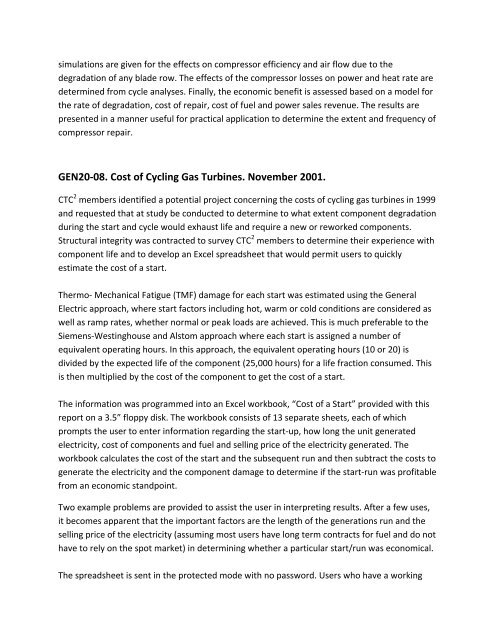GE94-02: Repair Flow Testing and Calibration Procedures for ...
GE94-02: Repair Flow Testing and Calibration Procedures for ...
GE94-02: Repair Flow Testing and Calibration Procedures for ...
You also want an ePaper? Increase the reach of your titles
YUMPU automatically turns print PDFs into web optimized ePapers that Google loves.
simulations are given <strong>for</strong> the effects on compressor efficiency <strong>and</strong> air flow due to the<br />
degradation of any blade row. The effects of the compressor losses on power <strong>and</strong> heat rate are<br />
determined from cycle analyses. Finally, the economic benefit is assessed based on a model <strong>for</strong><br />
the rate of degradation, cost of repair, cost of fuel <strong>and</strong> power sales revenue. The results are<br />
presented in a manner useful <strong>for</strong> practical application to determine the extent <strong>and</strong> frequency of<br />
compressor repair.<br />
GEN20‐08. Cost of Cycling Gas Turbines. November 2001.<br />
CTC 2 members identified a potential project concerning the costs of cycling gas turbines in 1999<br />
<strong>and</strong> requested that at study be conducted to determine to what extent component degradation<br />
during the start <strong>and</strong> cycle would exhaust life <strong>and</strong> require a new or reworked components.<br />
Structural integrity was contracted to survey CTC 2 members to determine their experience with<br />
component life <strong>and</strong> to develop an Excel spreadsheet that would permit users to quickly<br />
estimate the cost of a start.<br />
Thermo‐ Mechanical Fatigue (TMF) damage <strong>for</strong> each start was estimated using the General<br />
Electric approach, where start factors including hot, warm or cold conditions are considered as<br />
well as ramp rates, whether normal or peak loads are achieved. This is much preferable to the<br />
Siemens‐Westinghouse <strong>and</strong> Alstom approach where each start is assigned a number of<br />
equivalent operating hours. In this approach, the equivalent operating hours (10 or 20) is<br />
divided by the expected life of the component (25,000 hours) <strong>for</strong> a life fraction consumed. This<br />
is then multiplied by the cost of the component to get the cost of a start.<br />
The in<strong>for</strong>mation was programmed into an Excel workbook, “Cost of a Start” provided with this<br />
report on a 3.5” floppy disk. The workbook consists of 13 separate sheets, each of which<br />
prompts the user to enter in<strong>for</strong>mation regarding the start‐up, how long the unit generated<br />
electricity, cost of components <strong>and</strong> fuel <strong>and</strong> selling price of the electricity generated. The<br />
workbook calculates the cost of the start <strong>and</strong> the subsequent run <strong>and</strong> then subtract the costs to<br />
generate the electricity <strong>and</strong> the component damage to determine if the start‐run was profitable<br />
from an economic st<strong>and</strong>point.<br />
Two example problems are provided to assist the user in interpreting results. After a few uses,<br />
it becomes apparent that the important factors are the length of the generations run <strong>and</strong> the<br />
selling price of the electricity (assuming most users have long term contracts <strong>for</strong> fuel <strong>and</strong> do not<br />
have to rely on the spot market) in determining whether a particular start/run was economical.<br />
The spreadsheet is sent in the protected mode with no password. Users who have a working


